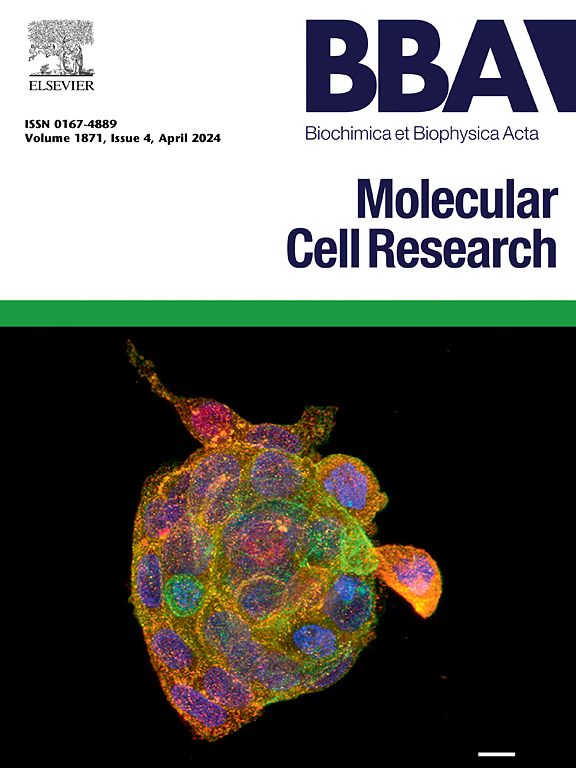类囊体Tat受体复合物表现为具有三个相关TatB亚基的同源三聚体TatC核心。
IF 3.7
2区 生物学
Q1 BIOCHEMISTRY & MOLECULAR BIOLOGY
Biochimica et biophysica acta. Molecular cell research
Pub Date : 2025-07-18
DOI:10.1016/j.bbamcr.2025.120024
引用次数: 0
摘要
双精氨酸易位(Tat)机制存在于大多数含有呼吸或光合电子传递链的细胞膜中,其特点是其独特的催化折叠蛋白的膜运输能力而不损害膜电位。在植物类囊体中,Tat机制由三个亚基TatA、TatB和TatC组成,后两个亚基TatB和TatC形成膜积分多聚体TatBC受体复合物。在这里,我们分析了这些配合物的稳定性和亚基组成与温和的洗涤剂洋地黄苷溶解后的类囊体,并经过额外的亲和纯化。采用不同的洗涤剂组合和/或热处理(40 °C),然后进行BN-PAGE和Western分析,我们可以鉴定出四种不同的Tat配合物,其表观分子质量约为230 kDa至620 kDa。用热或DDM或Triton X-114等洗涤剂处理最大的Tat配合物,导致其逐步分解为三个较小的配合物,这是由于相对稳定的TatC核心配合物连续释放TatB亚基。根据这些数据,我们假设完全组装的生理活性TatBC受体复合物由一个稳定的三聚体TatC核心组成,其中三个TatB亚基彼此独立结合。本文章由计算机程序翻译,如有差异,请以英文原文为准。

The thylakoidal Tat receptor complex appears as a homo-trimeric TatC core with three associated TatB subunits
The Twin-arginine translocation (Tat) machinery, which is found in most cellular membranes containing a respiratory or photosynthetic electron transport chain, is characterized by its unique ability to catalyze membrane transport of folded proteins without impairing the membrane potential. In plant thylakoids, Tat machinery consists of three subunits, TatA, TatB, and TatC, with the latter two, TatB and TatC, forming membrane-integral multimeric TatBC receptor complexes. Here we have analyzed the stability and the subunit composition of these complexes after solubilization of thylakoids with the mild detergent digitonin as well as after additional affinity-purification. Employing different detergent combinations and/or heat treatment (40 °C) followed by BN-PAGE and Western analysis we could identify four distinct Tat complexes with apparent molecular masses ranging from approximately 230 kDa to 620 kDa. Treatment of the largest Tat complex with either heat or detergents like DDM or Triton X-114 led to its stepwise breakdown into the three smaller complexes resulting from the successive release of TatB subunits from a relatively stable TatC core complex. From these data we postulate that the fully assembled, physiologically active TatBC receptor complex consists of a stable, trimeric TatC core to which three TatB subunits are bound independently from each other.
求助全文
通过发布文献求助,成功后即可免费获取论文全文。
去求助
来源期刊
CiteScore
10.00
自引率
2.00%
发文量
151
审稿时长
44 days
期刊介绍:
BBA Molecular Cell Research focuses on understanding the mechanisms of cellular processes at the molecular level. These include aspects of cellular signaling, signal transduction, cell cycle, apoptosis, intracellular trafficking, secretory and endocytic pathways, biogenesis of cell organelles, cytoskeletal structures, cellular interactions, cell/tissue differentiation and cellular enzymology. Also included are studies at the interface between Cell Biology and Biophysics which apply for example novel imaging methods for characterizing cellular processes.

 求助内容:
求助内容: 应助结果提醒方式:
应助结果提醒方式:


